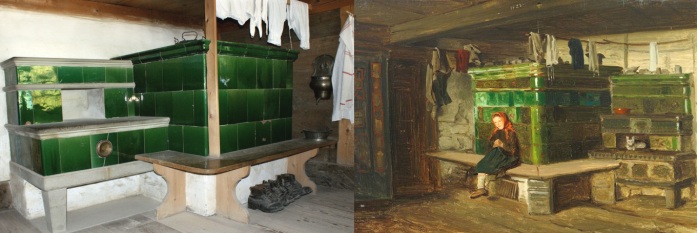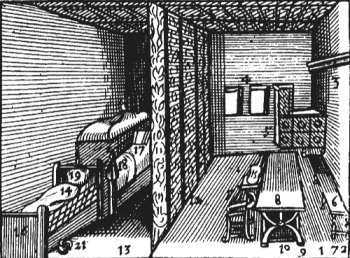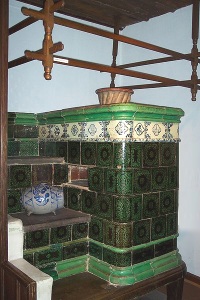
Tiled stoves were a wonderful way of heating homes in Northern Europe. I’ve often wondered why the British never used them. The settlers in North America hardly used them either, even in regions with bitter cold winters. At first they seem to have followed the British idea of having a fire to warm yourself by, rather than trying to keep a whole room warm. In English-speaking countries the open hearth reigned supreme long after other nations had taken to stoves, although there were some iron stoves in the early USA and colonial New England…. but I’ll write about them another day. This is more about ceramic glazed tile stoves, sometimes known by their German name of Kachelofen.
Stoves warm rooms more efficiently and cleanly than open fires. Heat doesn’t escape up the chimney, it’s safer and easier to keep them going overnight, and you don’t have to chop down so many trees to fuel them. (The Green movement has rediscovered wood-burning stoves.)
What explanations could there be for the traditional British resistance to stoves for heating? Some I’ve considered are discussed in Priscilla Brewer’s From Fireplace to Cookstove: Technology and the Domestic Ideal in America – essential reading if you’re interested in the history of heating and cooking stoves in the US. Can you think of any apart from these three?

- Milder winters than the rest of northern Continental Europe
- Distaste for the “unhealthy” idea of an enclosed warm room with “no” fresh air, no open chimney
- Feeling that open fires are part of the British way of life – supported by Lawrence Wright in the 1960s in Home Fires Burning
The stoves pictured here are not from mansions. There certainly are many fine stoves in palaces and grand houses, but these are the kind you can see in simple or middling houses.
Green seems to be a popular tile colour for rustic German stove rooms, with their characteristic benches and drying racks. In Sweden there are lots of tall, white stoves. If anyone knows more about regional styles of ceramic stove I’d love to hear from you.
A stove-room for the stove?

A stove used to mean a heated room, and not the thing heating it. In the 15th century the idea of keeping a living room warm, with heat radiating out through glazed tiles or iron panels, started to spread in German-speaking parts of Europe. There was still an open fire in the kitchen for cooking. This could be connected to an enclosed oven-box in the next room to create a warm space called the “stove” (German “Stube“). There might be enough heat to warm an adjacent bedroom too. It was a big step forward in comfort for people living in ordinary homes. A French traveller reported:
For the cold …. [German people] have stoves that heat in such a way that they are warm in their rooms, and in winter craftsmen do their work and keep their wives and children there and it takes very little wood to heat them.
Gilles le Bouvier, Livre de la description des pays, mid-15th century

In many countries the heating “box” is still called an oven (German Ofen), but English speakers have got used to calling it a stove, and have forgotten that stove used to mean a room. In the 17th century illustration above the oven is in the back right corner, numbered 5. Here’s a list of the things pictured: from the 1659 English edition of Comenius‘ school book Orbis Pictus, with the original punctuation.
The Stove 1. is beautified with an Arched-Roof 2. & wainscotted walls, 3 It is enlighted with Windows; It is heated with an Oven.
Its Utensils are, Benches, Stools, 7, Tables, 8, with Tressels, 9, Footstools, 10. and Cushions, 11.
There are also Tapestry hanged. 12. for soft lodging, in a sleeping-room, 13. there is a Bed 14. spread on a Bed-stead, 15. upon a Straw-pad, 16. with Sheets, 17. and Cover lids, 18. The Bolster 19. is under ones head. The Bed is covered with a Canopy 20. A Chamber-Pot 21 is for making water in.

Photos
Photographers credited in captions. Links to originals here: Swiss stove, Lithuanian stove, Alsatian stove. More picture info here
//
http://pagead2.googlesyndication.com/pagead/show_ads.js
Excellent post, thank you. I love these tiled stoves.
Regards, Keith.
A Woodsrunner’s diary.
LikeLike
Glad you like them too!
LikeLike
Hi, just letting you know I’ve reposted this awesome post on my blog. PioneerHandbooks.blogspot.com
Great post, I want a tiled stove now!
LikeLike
Nice to meet another tiled stove fan! After a quick look at your site, I can see I’ll want to spend more time there very soon. Thanks for coming here to comment.
LikeLike
Just discovered these beautiful tiled stoves at a museum in Germany. Would love to have something like this in a new home we plan on building. We live in a very cold area of Colorado.
LikeLike
I’ve seem these in use in family pictures fron Germany (Hamburg), mainly in older apartments. If you really want to have one made, I’d search websites in that area.
LikeLike
If you have the chance to look into older houses in East Germany, you will find a lot of these ovens. We still keep a pink (!) monstrum from the 1930 in the old house which we bought, it just needs a small repair, but it will work for more generations.
These ovens are really ugly, colours are (yellow-)green, light blue, baby shit yellow, and unfortunately pink / light red (as our model)
After 1989, many people destroyed these ovens and built central heating, now they are unhappy because of the high prices for energy and whish they had kept their kachelofen….
LikeLike
Hi,
I did like your article, but I must let you know that tile stoves are well known and used still in all Eastern Europe, in countries like Poland, Czech Republic, Lithuania, Russia and so on.
They have fallen out of fashion in ’80s and ’90 but now they come back.
Partially, it is caused by gas prices, but more it is due to stove producing completely different kind of heath. It is not based on warm air circulation, but on microwaves. The special kind of bricks (fireclay) give away microwaves. Tiles do store warmth but the stove can have also clay finish. Room heated in this method feels 4-5C warmer than thermometer indications – those waves literally warm you up from the inside ( kind of v. low power microwave 🙂 They do not dry up the air and do not cause excessive dust circulation – allergy sufferers love stoves!
I intend to put at least 3 in my brand new build. Can’t wait!
Greetings to all things past enthusiasts!
LikeLike
Where could you buy a nice tile stove in the USA? I would like one in our house.
LikeLike
My husband’s family is Russian Mennonite, and in “Mennonite Foods and Folkways from South Russia” (volume 2 I believe) there is a sketch of the giant stoves that they would use in the colonies there. It would sit in the kitchen (so for cooking, not just heating), against the wall of the “Vorderhaus” (fore-house in low German). There would also be a brick stove in the “Grossetube” (living room/parlour).
On further examination it appears that the sketch is for the outdoor oven for summertime use. But there are stoves mentioned in several rooms, so they were clearly used for heating.
LikeLike
Originally built in 1929, it covered over 23000 square
feet of land. If you are looking to create a traditional French style home you will need to think
about redecorating, replacing some of your ultra modern furniture and purchasing some new items
that are in keeping with the French style. Be sure
to check the weather channel to make sure you will have dry conditions.
LikeLike
I truly love your site.. Great colors & theme. Did you build this site
yourself? Please reply back as I’m trying to create my own personal site and would
like to learn where you got this from or just what the theme is called.
Thank you!
LikeLike
Any person have any sort of clever ideas for outdoor
storage? We have some good outdoor patio chairs yet
I’m fed up with the cushions becoming drenched in the rain and I do not have anywhere to store the
household furniture; coolestkidsfurniture.com,.
LikeLike
Excellent post. I was checking constantly this blog and I’m impressed!
Extremely useful information specially the last part 🙂 I care for such info a lot.
I was looking for this particular info for a very long time.
Thank you and good luck.
LikeLike
This text is worth everyone’s attention. When can I
find out more?
LikeLike
Simply want to say your article is as surprising.
The clearness to your put up is simply cool
and i can think you are knowledgeable on this subject.
Well along with your permission let me to grab your RSS feed to keep updated
with impending post. Thanks a million and please carry on the enjoyable work.
LikeLike
Hi I just wanted to mention that I saw a wonderful, very simple tiled woodstove in an outdoor ethnographic museum in Lithuania a while ago. It had a tiled stove inside in the living sleeping room with sleeping platforms around it, and it was stoked with logs from the inner porch where the opening/firebox of the stove, and a stack of logs were kept. Ingenious, simple, clean,practical and beautiful too. My grandmother had such a one in her homestead there in Lithuania at the end of the 19th century. So happy to have seen it, and your site too. Thanks.
LikeLike
Thanks for the info, now, where can I find one around here? I live in Phoenix Az,(I know, most of the time is 115 here:) but plan to retire south east of Tucson.
LikeLike
Traditionally SW families gathered near the chiminea for warmth.
LikeLike
Thank you for the article! We just purchased a home in a Germany with a green tile stove and hanging rack. We had no idea it was a tradition. I was looking up how to use it properly when I discovered your article. I’d be happy to send you a photo if you’d like.
LikeLike